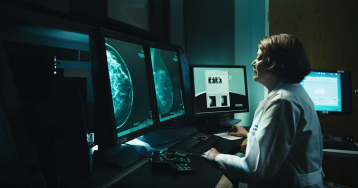
We know that mammography can hurt. We like to think of it as “uncomfortable.” But I think, for some women, it must feel more painful than it does for others. We do have to compress the breast tissues to see detail in the images.
If you find it terribly painful, take a Tylenol or Aleve before you come in. That will help a lot.
Remind yourself that it’s just for a few minutes, as we image each breast. Try to think about something else while it’s happening. Play your favorite song in your head. Or your favorite quote. Or picture someone you love. You’re doing this for yourself – and for them.
Don’t let the thought of pain prevent you from getting your yearly mammogram. There’s so much about mammography that’s worth the momentary hurt.
With our newest technology, three-dimensional (3D) screening mammography, we can see masses (tumors) much more easily. We can see the tiny ones – but we can also see those that get hidden behind dense breast tissue. In some cases, the hidden tumors may be relatively large.
With 3D mammography, the technology is able to convert digital breast images – the ones we get in your screening — into a series of very thin layers. I sometimes call them “slices,” because they give us a cross-section view of breast tissue. It’s similar to seeing the pages in a book.
With this series of paper-thin images, we see much more detail, compared to traditional two-dimensional mammography.
If those tiny or large tumors are hiding among the milk ducts and blood vessels, we will see them. It’s very exciting – a real breakthrough.
It’s the biggest advantage over traditional mammography – that ability to see all the masses in all types of breasts. This is true with dense breasts, but also fatty breasts. We can find them at an earlier stage, when they are most treatable – and most curable.
With this level of detail in 3D mammography, the number of “call-backs” is much lower — from 20 to 40 percent less. For our patients, that means far less anxiety while they wait. Insurance companies like that, because it cuts back on extra fees.
If you’re age 40 or over, don’t wait to have a mammogram. There’s no time like the present to start this yearly tradition. At least 25 percent of all breast cancers are found in women under age 50 – and we don’t want to miss those.
If you’re over age 50, it’s just as critical that you keep getting those annual mammograms. If you skip a year or two, a tumor may be too big to be curable by the time we find it. The smaller the cancer, the more likely it is curable.
With 3D mammography, the cancer detection rates have increased by 40 percent. That’s astounding!
Is it time for your annual mammogram? Make your appointment at Nebraska Medicine by calling 800-922-0000.


